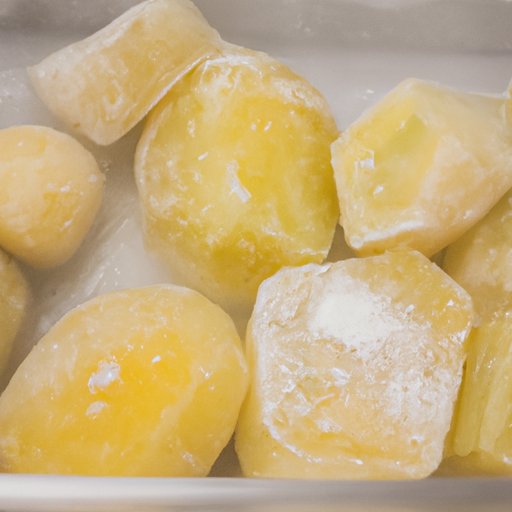
I. Introduction
Freezing potatoes is a great way to extend their shelf life and ensure that you always have potatoes on hand for your favorite recipes. However, freezing potatoes requires a few special steps to ensure that they retain their flavor and texture. In this article, we’ll provide a step-by-step guide to freezing potatoes, including the best types of potatoes to freeze, different freezing methods, and best practices for storing frozen potatoes.
II. Step-by-Step Guide
Before freezing potatoes, it’s important to select the right type of potato for freezing. Choose potatoes that are firm and have a low moisture content, such as Russet, Yukon Gold, or Kennebec potatoes. Avoid potatoes with a high moisture content, such as new potatoes or fingerlings, as they may become watery when frozen.
To freeze potatoes, start by washing and peeling them. Cut them into the desired size and shape, such as cubes or slices, and blanch them in boiling water for a few minutes. Blanching helps to stop the enzyme activity that can cause the potatoes to discolor and lose their flavor. After blanching, drain the potatoes and let them cool to room temperature. Then, spread them out in a single layer on a baking sheet and place them in the freezer. Once frozen, transfer the potatoes to freezer bags or containers and label them with the date and type of potato. Frozen potatoes can last up to a year in the freezer.
III. Different Methods
While blanching is the most effective method for freezing potatoes, there are other methods to consider. For example, you can parboil potatoes instead of blanching them, which involves boiling them for a few minutes until they are partially cooked but still firm. Another option is to freeze potatoes raw, by simply cutting them into cubes or slices and placing them in the freezer without blanching or parboiling them. However, raw freezing may result in a poorer quality potato, as they can become mushy or lose their flavor over time.
The best method for freezing potatoes depends on the type of potato and the intended use. Blanching is recommended for all types of potatoes, while parboiling is best for waxy potatoes that hold their shape, such as red potatoes. Raw freezing is best avoided, as it can lead to decreased quality and flavor.
IV. Pre-Prepared Dishes
In addition to freezing whole or sliced potatoes, you can also freeze pre-prepared potato dishes for later use. Some popular pre-prepared dishes include mashed potatoes, French fries, and hash browns. To freeze mashed potatoes, simply cook the potatoes as you normally would, mash them, and mix in butter, milk, and any other desired seasonings. Let the mashed potatoes cool, then portion them into freezer-safe bags or containers. French fries and hash browns can be frozen raw or cooked, depending on the recipe. Pre-freeze them on a baking sheet before transferring them to a container to prevent them from sticking together. Frozen pre-prepared potato dishes can last for up to six months in the freezer.
V. Best Practices for Storing Potatoes
Proper storage is key to keeping frozen potatoes fresh and preventing spoilage. After blanching or parboiling, make sure the potatoes are completely dry before freezing them. Store the potatoes in airtight containers or freezer bags, removing as much air as possible before sealing. Label the containers with the date and type of potato for easy identification. To prevent freezer burn, place the containers in the coldest part of the freezer, away from the door.
Another best practice for storing potatoes is to invest in equipment that can help keep them fresh. For example, vacuum sealers can remove all air from freezer bags and containers, preventing freezer burn and extending the shelf life of frozen potatoes. Dehydrators are also useful for removing moisture from potatoes before freezing them, which can help prevent them from becoming mushy.
VI. Tips for Perfect Freezing
To freeze potatoes to perfection, there are a few tips and tricks to keep in mind. First, make sure the potatoes are completely dry before freezing them, as excess moisture can lead to ice crystals and freezer burn. When freezing pre-prepared potato dishes, place them in a single layer on a baking sheet to prevent them from sticking together before transferring them to freezer bags or containers. When freezing raw potatoes, choose potatoes that are similar in size and shape to ensure even freezing.
To prevent freezer burn and retain quality, wrap the potatoes in a layer of wax paper or plastic wrap before placing them in freezer bags or containers. Lastly, avoid thawing and refreezing potatoes, as this can damage their texture and flavor.
VII. Alternative Uses for Frozen Potatoes
Aside from using frozen potatoes in your favorite recipes, there are many alternative uses for them as well. For example, grated frozen potatoes can be used to make potato pancakes, while mashed potatoes can be used in dishes like shepherd’s pie. To prepare frozen potato ready meals, cook potatoes in a variety of ways, such as roasting, boiling, or mashing, and portion them out into freezer-safe containers. Then, simply thaw and reheat the potatoes for a quick and easy meal.
VIII. Conclusion
Freezing potatoes is a great way to ensure that you always have potatoes on hand for your favorite recipes. By selecting the right type of potato and following our step-by-step guide, you can safely freeze potatoes for up to a year without losing their texture or flavor. Whether you’re freezing whole potatoes or pre-prepared dishes, best practices for storing potatoes and tips for perfect freezing will help you to retain their quality for later use. Be sure to try freezing potatoes for yourself and enjoy the convenience of always having them available.





